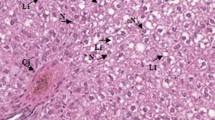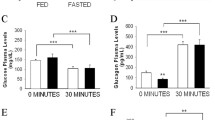Abstract
In order to gain information on the determinism of the perturbation of fuel homeostasis in situations characterized by a depletion in long-chain polyunsaturated ω3 fatty acids (ω3), the metabolic and hormonal status of ω3-depleted rats (second generation) was examined. When required, these rats were injected intravenously 120 min before sacrifice with a novel medium-chain triglyceride-fish oil emulsion able to provoke a rapid and sustained increase of the ω3 content in cell phospholipids. The measurement of plasma glucose, insulin, phospholipid, triglyceride, and unesterified fatty acid concentration indicated modest insulin resistance in the ω3-depleted rats. The plasma triglyceride and phospholipid concentrations were decreased in the ω3-depleted rats with abnormally low contribution of ω3 in both circulating and pancreatic islet lipids. The protein, insulin, and lipid content of the islets, as well as their intracellular and extracellular spaces, were little affected in the ω3-depleted rats. The metabolism of d-glucose in the islets of ω3-depleted rats was characterized by a lesser increase in d-[5-3H]glucose utilization and d-[U−14C]glucose oxidation in response to a given rise in hexose concentration and an abnormally low ratio between d-glucose oxidation and utilization. These abnormalities could be linked to an increased metabolism of endogenous fatty acids with resulting alteration of glucokinase kinetics. The release of insulin evoked by d-glucose, at a close-to-physiological concentration (8.3mM), was increased in the ω3-depleted rats, this being considered as consistent with their insulin resistance. Relative to such a release, that evoked by a further rise in d-glucose concentration or by non-glucidic nutrients was abnormally high in ω3-depleted rats, and restored to a normal level after of the intravenous injection of the ω3-rich medium-chain triglyceride-fish oil emulsion. Because the latter procedure failed to correct the perturbation of d-glucose metabolism in the islets of ω3-depleted rats, it is proposed that the anomalies in the secretory behaviour of islets in terms of their response to an increase in hexose concentration or non-nutrient secretagogues is mainly attributable to alteration in K+ and Ca2+ handling, as indeed recently documented in separate experiments.
Similar content being viewed by others

References
Simopoulos, A. (2002). Biomed. Pharmacother. 56, 365–379.
Benatti, P., Peluso, G., Nicoloai, R., and Calvani, M. (2004). J. Am. Coll. Nutr. 23, 281–302.
Seo, T., Blaner, W. S., and Deckelbaum, R. J. (2005). Curr. Opin. Lipidol. 16, 11–18.
Delaure, J., LeFoll, C., Corporeau, C., and Lucas, D. (2004). Reprod. Nutr. Dev. 44, 289–299.
Portois, L., Peltier, S., Chardigny, J.-M., et al. (2005). Eur. J. Physiol. 450, R11 (abstract).
Malaisse, W. J., Sancho, V., Acitores, A., et al. (2005). Program of the 87th annual meeting of the Endocrine Society, San Diego, CA, 2005, p. 592 (Abstract P3-198).
Oguzhan, B., Sancho, V., Acitores, A., et al. (2005). Diabetologia 48(Suppl. 1), A209 (Abstract).
Courtois, P., Zhang, Y., Louchami, K., et al. (2005). Diabetologia 48(Suppl. 1), A430 (Abstract).
Malaisse, W. J., Louchami, K., Zhang, Y., et al. (2005). Diabetes 54(Suppl. 1), A653 (Abstract 2714-PO).
Louchami, K., Zhang, Y., Oguzhan, B., et al. (2005). Diabetologia 48(Suppl. 1), A168 (Abstract).
Zhang, Y., Oguzhan, B., Louchami, K., et al. (2006). Am. J. Physiol., in press.
Portois, L., Deckelbaum, R. J., Malaisse, W. J., and Carpentier, Y. A. (2004). Nutr. Clin. Metab. 18(Suppl. 1), S53 (Abstract).
Yazici, Z., Sener, A., and Malaisse, W. J. (1994). Med. Sci. Res. 22, 377–378.
Konrad, R. J., Stoller, J. Z., Gao, Z. Y., and Wolf, B. A. (1996). Pancreas 13, 253–258.
Opara, E. C., Hubbard, V. S., Burch, W. M., and Akwari, O. E. (1992). Endocrinology 130, 657–662.
Steerenberg, P. A., Beekhof, P. K., Feskens, E. J., Lips, C. J., Hoppener, J. W., and Beems, R. B. (2002). Diab. Nutr. Metab. 15, 205–214.
Chicco, A., D'Alessandro, M. E., Karabatas, L., Gutman, R., and Lombardo, Y. B. (1996). Ann. Nutr. Metab. 40, 61–70.
Holness, M. J., Greenwood, G. K., Smith, N. D., and Sugden, M. C. (2003). Endocrinology 144, 3958–3968.
Hollness, M. J., Smith, N. D., Greenwood, G. K., and Sugden, M. C. (2004). Diabetes 53(Suppl. 1), S166-S171.
Carpentier, Y. A., Peltier, S., Portois, L., et al. (2004). Nutr. Clin. Metab. 18(Suppl. 1), S36 (Abstract).
Malaisse, W. J., Hutton, J. C., Kawazu, S., Herchuelz, A., Valverde, I., and Sener, A. (1979). Diabetologia 16, 331–341.
Malaisse, W. J. (1972). In: Endocrine pancreas. Steiner, D. F. and Freinkel, N. (eds.). American Physiological Society: Washington, DC.
Zimmer, L., Delion-Vancassel, S., Durand, G., et al. (2000). J. Lipid Res. 41, 32–40.
Bergmeyer, H. U. and Berndt, E. (1974). In: Methods of enzymatic analysis. Bergmeyer, H. U. (ed.). Academic: New York.
Leclercq-Meyer, V., Marchand, J., Woussen-Colle, M.-C., Giroix, M.-H., and Malaisse, W. J. (1985). Endocrinology 116, 1168–1174.
Richelle, M., Carpentier, Y. A., and Deckelbaum, R. J. (1994). Biochemistry 33, 4872–4878.
Antrum, R. M. and Solomkin, J. S. (1986). Med. Lab. Sci. 43, 44–47.
Malaisse-Lagae, F. and Malaisse, W. J. (1984). In: Methods in diabetes research. Larner, J., and Pohl, S. J. (eds.) Wiley: New York.
Simoens, C., Richelle, M., Rössle, C., Derluyn, M., Deckelbaum, R. J., and Carpentier, Y. A. (1995). Clin. Nutr. 14, 177–185.
Lowry, O. H., Rosebrough, N. J., Farr, A. L., and Randall, R. J. (1951). J. Biol. Chem. 153, 265–275.
Wieland, O. (1974). In: Methods of enzymatic analysis. Bergmeyer, H. U. (ed.). Academic: New York.
Ramirez, R., Rasschaert, J., Laghmich, A., et al. (2001). Int. J. Mol. Med. 7, 631–638.
Malaisse, W. J. and Sener, A. (1988). Biochim. Biophys. Acta 971, 246–254.
Author information
Authors and Affiliations
Corresponding author
Rights and permissions
About this article
Cite this article
Oguzhan, B., Zhang, Y., Louchami, K. et al. Pancreatic islet function in ω3 fatty acid-depleted rats. Endocr 29, 457–466 (2006). https://doi.org/10.1385/ENDO:29:3:457
Received:
Revised:
Accepted:
Issue Date:
DOI: https://doi.org/10.1385/ENDO:29:3:457



